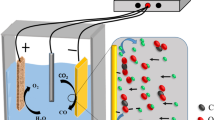Abstract
Utilization of carbon dioxide for the production of value added products is a challenging task. Electrochemical reduction of carbon dioxide is one of the most promising techniques to convert the carbon dioxide into value added products. However, the development and selection of a suitable electrocatalyst is not so straightforward. The main problems are non-selectivity of the electrocatalyst toward CO2 reduction, simultaneous hydrogen evolution reaction, and low efficiency of the process. To overcome these problems, many electrocatalysts have been studied and reported in the literature. However, there is no effective guideline to screen the electrocatalysts in a quick and simple way. Moreover, it is found that the method used for the screening of electrocatalyst is not accurate and has anomalies. Therefore, in this paper, a simple and quick protocol based on half-cell tests is proposed. The method provides a first-hand prediction about the electrochemical activity of an electrocatalyst toward electrochemical reduction of carbon dioxide. The protocol was validated and compared along with confirming the results by product analysis of the electrochemical reduction of CO2 using full electrochemical reactor. The method was found satisfactory for the preliminary screening of electrocatalyst to reduce carbon dioxide electrochemically.



Similar content being viewed by others
References
Aeshala LM, Rahman SU, Verma A (2011) Development of a reactor for continuous electrochemical reduction of CO2 using solid polymer electrolyte. Proceedings of ASME 2011 5th international conference on energy sustainability, Paper No. ES2011-54755, Washington, DC, pp 1–7
Aeshala LM, Rahman SU, Verma A (2012) Effect of solid polymer electrolyte on electrochemical reduction of CO2. Sep Purif Technol 94:131–137. doi:10.1016/j.seppur.2011.12.030
Aeshala LM, Uppaluri RG, Verma A (2013) Effect of cationic and anionic solid polymer electrolyte on direct electrochemical reduction of gaseous CO2 to fuel. J CO2 Util 3–4: 49–55. doi:10.1016/j.jcou.2013.09.004
Chieng BW, Loo YY (2012) Synthesis of ZnO nanoparticles by modified polyol method. Mater Lett 73:78–82. doi:10.1016/j.matlet.2012.01.004
Hassan HS, Elkady MF, El-Shazly AH, Bamufleh HS (2014) Formulation of synthesized zinc oxide nanopowder into hybrid beads for dye separation. J Nano Mat 967492:1–14. doi:10.1155/2014/967492
He T, Chen D, Jiao X, Wang Y, Duan Y (2005) Solubility controlled synthesis of high quality Co3O4 nanocrystals. Chem Mater 17:4023–4030. doi:10.1021/cm050727s
Herrero M, Benito P, Labajos FM, Rives V (2007) Nanosize cobalt oxide containing electrocatalysts obtained through microwave assisted methods. Catal Today 128:129–137. doi:10.1016/j.cattod.2007.06.070
Hori Y (2003) CO2 reduction, catalyzed by metal electrodes. In: Vielstich W et al. (ed) Electrocatalysis, handbook of fuel cells, vol 2, Wiley, Chichester, pp 720–732
Hori Y (2008) Electrochemical CO2 reduction on metal electrodes. In: Vayenas CG et al. Modern aspects of electrochemistry, vol 42 Springer, New York, pp 89–190
Hori Y, Suzuki S (1983) Electrolytic reduction of bicarbonate ion at mercury electrode. J Electrochem Soc 130(12):2387–2390. doi:10.1149/1.2119593
Hori Y, Takahashi I, Koga O, Hoshi N (2003) Electrochemical reduction of carbon dioxide at various series of copper single crystal electrodes. J Mol Catal A: Chem 199:39–47. doi:10.1016/S1381-1169(03)00016-5
Ikeda S, Hattori A, Maeda M, Ito K, Noda H (2000) Electrochemical reduction behaviour of carbon dioxide on sintered Zinc Oxide electrode in aqueous solution. Electrochem 68:257–261
Ikeda S, Ito K, Noda H (2009) Electrochemical reduction of carbon dioxide using gas diffusion electrodes loaded with fine electrocatalysts. Int Conf Nanosci Nanotechnol CP1136: 108–113
Keeling CD (1960) The concentration and isotopic abundance of carbon dioxide in the atmosphere. Tellus, Wiley Online Library 12(2):200–203
Lee J, Tak Y (2001) Electrocatalytic activity of Cu electrode in electroreduction of CO2. Electrochim Acta 46:3015–3022. doi:10.1016/S0013-4686(01)00527-8
Liu J, Huang X, Li Y, Sulieman KM, He X, Sun F (2006) Hierarchical nanostructures of cupric oxide on a copper substrate: controllable morphology and wettability. J Mater Chem 16:4427–4434. doi:10.1039/B611691D
Murata A, Hori Y (1991) Product selectivity affected by cationic species in electrochemical reduction of CO2 and CO at a Cu electrode. Bull Chem Soc Jpn 64:123–127
Renuka R, Srinivasan L, Ramamurthy S, Veluchamy A, Venkatakrishnan N (2001) Cyclic voltammetric study of zinc and zinc oxide electrodes in 5.3 M KOH. J Appl Electrochem 31:655–661
Scibioh MA, Viswanathan B (2004) Electrochemical reduction of carbon dioxide: a status report. Proc Indian Natl Sci Acad 70 A(3):407–462
Shuang S, Zhiqiao H, Jiexu Y, Jianmeng C (2006) Preliminary study on electrochemical reduction of carbon dioxide on Nickel and Platinum electrodes. High Technol Lett 12(3):333–336
Singh S, Aeshala LM, Verma A (2012) Sustainable production of fuel from electrochemical reduction of carbon dioxide. Int J Innov Res Dev 1(7):155–160
Suraja PV, Yaakob Z, Binitha NN, Triwahyono S, Silija PP (2013) Co3O4 doped over SBA 15: excellent adsorbent materials for the removal of methylene blue dye pollutant. Clean Technol Environ Policy 15(6):967–975. doi:10.1007/s10098-012-0558-2
Wu HQ, Wei XW, Shao MW, Gu JS, Qu MZ (2002) Synthesis of copper oxide nanoparticles using carbon nanotubes as templates. Chem Phys Lett 364:152–156. doi:10.1016/S0009-2614(02)01301-5
Yotsuhashi S, Taniguchi R, Zenitani Y (2012) Carbon dioxide reduction method, and carbon dioxide reduction electrocatalyst and carbon dioxide reduction device used for the method. United States Patent, Pub. No. US2012/0018311 A1
Acknowledgments
The authors are thankful to the National Program on Carbon Sequestration Research, Department of Science and Technology (DST), New Delhi for the financial support (project grant number DST/IS-STAC/CO2-SR-139/12(G)) and Central Instruments Facility, IIT Guwahati for the FESEM analysis.
Author information
Authors and Affiliations
Corresponding author
Rights and permissions
About this article
Cite this article
Singh, S., Mukherjee, C. & Verma, A. Development of catalytic activity protocol for electrochemical reduction of carbon dioxide to value added products. Clean Techn Environ Policy 17, 533–540 (2015). https://doi.org/10.1007/s10098-014-0796-6
Received:
Accepted:
Published:
Issue Date:
DOI: https://doi.org/10.1007/s10098-014-0796-6




